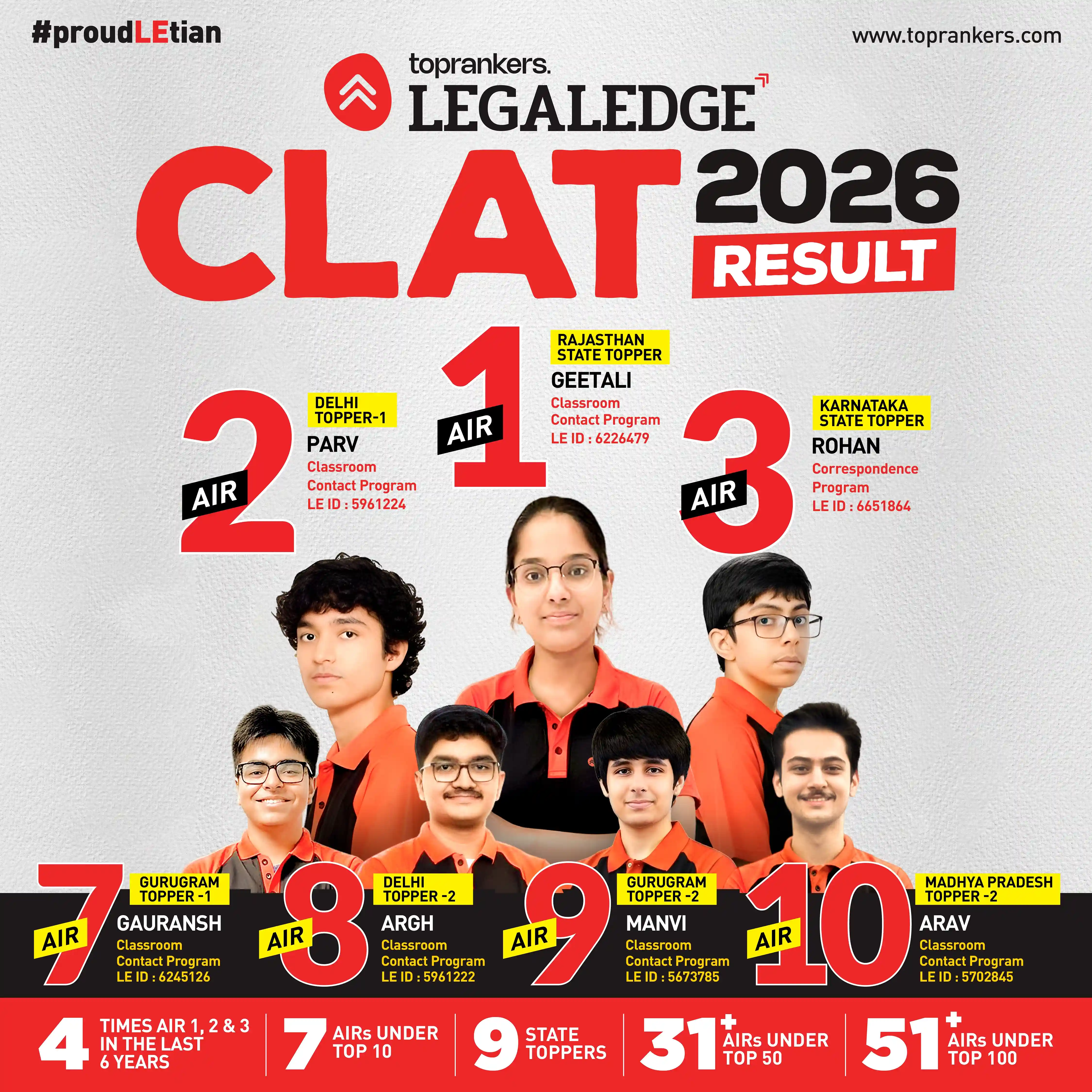Which Is Better Reading Newspaper or Watching Tv for CLAT 2026?
October 24, 2025
Reader’s Digest: Undoubtedly, current affairs and news hold the utmost importance for cracking CLAT 2026. But the question is which is the better option: reading a newspaper or watching TV for CLAT. Please read this blog to know the best source for news, its pros and cons, and more.
Over the past decades, how we consume news has changed a lot. Technology has made it much easier and more convenient to access news and current affairs. So which Is Better, Reading Newspapers or Watching TV for CLAT 2026?
This section focuses on how to retain information effectively. The more you expose yourself to and revise the information, the better you can remember and reuse it when needed. So, carefully considering the sources and mediums of preparation is essential.
Today, we have various options for getting news, such as news websites, apps, newspapers, and traditional TV news channels. But when preparing for CLAT 2026, how do you choose between watching the news on TV and reading newspapers?
For CLAT 2026 aspirants, both mediums have advantages and disadvantages. Let's examine each one in more detail.
Watching News on TV for CLAT 2026
The convenience factor is the most significant advantage of watching the news on TV.
Watching the news on TV is much easier than reading a newspaper.
There are two sides to a coin: heads and tails. Similarly, watching the news for CLAT current affairs has positives and negatives.
Pros of Watching News on TV for CLAT 2026
Here are some of the benefits of watching the news to ace the preparation for the Common Law Admission Test:
- Quick and Easy Updates: Turning on the TV instantly provides you with the latest news. There is no need to wait or search for updates; press a button!
- Mobility: Unlike newspapers, you can watch TV news even when you're on the move. You don't have to stay in one place to stay informed.
- Engaging and Enjoyable: Watching the news on TV is more exciting and enjoyable than reading it in a newspaper. Experienced professionals present the news in an engaging way, using visuals to make it more impactful.
- Enhanced Understanding: Visuals in TV news help you grasp the news better. Seeing what's happening gives you a clearer picture of the reported events.
- Diverse Perspectives: TV news often includes sound bites from experts, politicians, and regular people. These different perspectives make it easier to differentiate between facts and opinions and help you develop a more balanced view of the news.
Cons of Watching News on TV for CLAT 2026
If you are preparing for the CLAT Exam by watching the news, here are some drawbacks:
- Biased News: TV news channels may be influenced by their political affiliations, resulting in the presentation of biased news. This means the information you receive may only sometimes be impartial or accurate.
- Sensationalism: TV news often tends to be sensationalized. This means that news stories are presented exaggeratedly or dramatically, focusing more on grabbing attention rather than providing in-depth information. This sensationalism can divert your attention from essential details crucial for understanding the news accurately.
- Limited Perspective: TV news generally offers a limited perspective on events and issues. It may only present a narrow range of opinions or viewpoints, which can restrict your understanding of complex topics. This can hinder your ability to analyze and form well-rounded views on essential issues critically.
- Time Constraints: TV news has limited time slots for each story, resulting in a condensed version of events. This brevity may lead to the omission of essential details or important context. As a CLAT aspirant, having a comprehensive understanding of various subjects is crucial, and relying solely on TV news may limit your exposure to relevant information.
- Lack of Interactivity: Watching the news on TV is a passive activity. Compared to other sources of information, such as reading newspapers or online articles, you have limited opportunities to engage with the content actively. This can hinder your ability to ask questions, seek clarification, or delve deeper into the discussed topics.
- Inaccuracy and Misinterpretation: TV news can sometimes be inaccurate and misinterpretable. Due to the fast-paced nature of television broadcasting, information might not be thoroughly fact-checked or verified. Relying solely on TV news as your primary source of information may propagate misinformation or misunderstandings.
Check Out: Daily, Weekly and Monthly Current Affairs for CLAT 2026
Reading Newspaper for CLAT 2026
Reading newspapers is also a great way to stay informed about the latest developments and happenings in the legal field on national and international levels.
However, reading a newspaper has its own set of advantages and disadvantages.
Pros of Reading Newspapers for CLAT 2026
Refer to the below-mentioned pointers for the advantages of reading newspapers for CLAT.
- Newspapers are a valuable source of information for the Current Affairs section of CLAT.
- They contain relevant and up-to-date news that is essential for CLAT preparation.
- Reading newspapers regularly can help you stay updated with the latest events and developments.
- Newspapers offer detailed and comprehensive coverage of the news.
- They go beyond the surface-level information provided by television news.
- Newspapers delve deeper into current affairs, providing more in-depth reports and analyses.
- Editorial pages in newspapers present various perspectives on a particular topic.
- Different opinions expressed in these pages enable a better understanding of the discussed issue.
- Reading editorials can enhance your critical thinking and analytical skills, which benefit the CLAT Exam.
- Newspapers often feature investigative reports and opinion pieces.
- These pieces provide valuable insights and viewpoints on essential issues.
- Such content can help CLAT aspirants develop a broader understanding of various topics.
- Reading newspapers cultivates a reading habit and improves language skills.
- Regular reading enhances vocabulary, comprehension, and reading speed.
- These language skills are valuable for comprehending and answering CLAT questions effectively.
- Newspapers cover a wide range of topics beyond current affairs.
- They include sections on politics, law, economics, social issues, etc.
- Familiarizing yourself with diverse subjects through newspapers can broaden your knowledge base, which is advantageous for CLAT.
- Newspapers provide an opportunity to practice reading comprehension.
- The format of news articles helps develop the ability to extract information quickly.
- Reading comprehension skills through newspapers can improve performance in the comprehension section of the CLAT Exam.
Cons of Reading Newspapers for CLAT 2026
To know the disadvantages of reading newspapers for CLAT, refer to the following points:
- Difficulty in reading: Newspapers can be challenging to read.
- Articles in newspapers are often long and dense, which can make it hard to follow the news.
- The language used in newspapers may be complex or filled with jargon, making comprehension difficult for CLAT preparation.
- Lack of visuals: Newspapers often lack visual aids.
- Understanding the news can become more challenging without visual elements like images or charts.
- Visuals provide additional context and help grasp complex information, which is crucial for CLAT preparation.
- Limited interactivity: Newspapers offer limited interactivity compared to digital sources.
- Unlike digital platforms, newspapers do not allow direct engagement or participation.
- CLAT aspirants may find it beneficial to interact with the content, ask questions, or access additional resources, which can be limited in newspapers.
- Time constraints: Keeping up with newspapers can be time-consuming.
- CLAT preparation requires time management, and reading newspapers regularly may consume much time.
- It can be challenging to allocate time for thorough newspaper reading while balancing other study materials and practice sessions.
- Lack of real-time updates: Newspapers may need to provide real-time updates.
- News articles in newspapers are typically published daily or weekly, which means they might not cover the latest developments.
- CLAT aspirants must stay updated with current affairs, and relying solely on newspapers may result in missing time-sensitive information.
- Bias and limited perspectives: Newspapers may exhibit bias and offer limited perspectives.
- Different newspapers have editorial stances and may present news from a particular viewpoint.
- CLAT requires a well-rounded understanding of various perspectives, and relying solely on newspapers may restrict exposure to diverse opinions.
Final Say: Which is the Better Option: Reading a Newspaper or Watching TV for CLAT 2026
Choosing between Which is the Better Option: Reading a Newspaper or Watching TV for CLAT 2026 current affairs is not straightforward. Both mediums have their advantages and disadvantages. However, a well-rounded approach combining both benefits can be more beneficial for CLAT 2026 preparation.
Here's how you can make the most out of each medium:
Utilize TV News:
- Watching the news on TV provides quick and easy updates, instantly informing you about the latest events.
- The engaging nature of TV news, visuals, and diverse perspectives can enhance your understanding and provide a more balanced view of the news.
- However, be aware of potential biases, sensationalism, limited perspectives, time constraints, and the lack of interactivity and accuracy that can accompany TV news.
To make the most of TV news:
- Use it as a quick source of updates and breaking news.
- Pay attention to different perspectives presented and critically analyze the information.
- Supplement it with additional research and fact-checking to ensure accuracy.
- Be mindful of sensationalism and biases by cross-referencing with other sources.
Harness the Power of Newspapers:
- Reading newspapers offers comprehensive and in-depth coverage of news, which goes beyond what TV news provides.
- It helps develop critical thinking, analytical skills, and a broader understanding of various subjects.
- While newspapers may present challenges like difficulty in reading, lack of visuals, limited interactivity, time constraints, and potential biases, they remain a valuable source of information.
To effectively utilize newspapers:
- Prioritize important news articles and sections relevant to CLAT preparation.
- Break down complex articles into manageable parts for better comprehension.
- Look for diverse perspectives presented in editorials and opinion pieces.
- Develop a reading habit, enhance language skills, and practice reading comprehension.
- Supplement newspaper reading with real-time updates from other sources.
Conclusion
To get a better grasp of current events for CLAT 2026, it's important to find a middle ground between TV news and newspapers.
TV news offers convenience and visual impact, while newspapers provide in-depth analysis.
However, it's crucial to evaluate information from both sources critically, verify facts independently, and consider using additional resources for better preparation.
Frequently Asked Questions
Which newspaper is best for CLAT Preparation?

What should be read in Newspaper for CLAT?

How to read newspaper for CLAT Exam?

How can I improve my vocabulary while reading a newspaper for CLAT exam?

Is it necessary to read all the news present in the newspaper for CLAT?

How much time can I give for reading a newspaper for CLAT?








SHARE